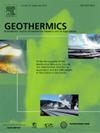Lithospheric structure and thermal effect in the collisional orogen, Northeastern Tibetan Plateau
IF 3.9
2区 工程技术
Q3 ENERGY & FUELS
引用次数: 0
Abstract
Lithospheric thermal structure and temperature field characteristics are essential for understanding the rheological properties and geothermal anomalies in the collisional orogen. In this study, we systematically modelled the lithospheric structure in light of the stratified crustal structure revealed by the seismic profiles in the Northeastern Tibetan Plateau (Maduo-Gonghe-Yabrai). Furthermore, using thermophysical data and CRUST 1.0 model, we calculated the thermal background to assess the lateral disparities in the thermal effect across the collisional orogen. The results reveal that, across the Haiyuan Fault, there are significant variations in the lithospheric thermal structure. On the orogen side, crustal thickness and heat flow ranges from 50 to 62 km and from 55 to 120 mW/m², respectively, which is primarily dominated by a higher temperature anomaly zone related to thickened crustal partial melting. Numerical simulation shows the partial melting temperatures could reach 650–700 °C at depths of approximately 20 km. In contrast, on the Alxa Block side, crustal thickness ranges from 45 to 47 km with heat flow values between 40 and 54 mW/m², and crustal heat flow contributes less. The study suggests that regional middle-crustal partial melting is the primary heat source for the regional geothermal anomalies in the Northeastern Tibetan Plateau. Additionally, the Cenozoic crustal extension by conjugate strike-slip faulting led to lithosphere uplift. This, in turn, promoted thermal upwelling and transferred heat to the upper crust and sedimentary layers, ultimately resulting in the formation of a regional geothermal anomaly.
岩石圈热结构和温度场特征是了解碰撞造山带流变学性质和地热异常的基础。此外,利用热物理数据和地壳1.0模型,计算热背景,评价碰撞造山带热效应的横向差异。结果表明,在整个海原断裂上,岩石圈热结构存在明显的变化。造山带侧地壳厚度为50 ~ 62 km,热流为55 ~ 120 mW/m²,主要以地壳部分熔融增厚相关的高温异常带为主。数值模拟表明,在深度约20公里处,部分熔融温度可达650-700℃。阿拉善地块一侧地壳厚度为45 ~ 47 km,热流值为40 ~ 54 mW/m²,地壳热流贡献较小。此外,新生代共轭走滑断裂作用下的地壳伸展作用导致岩石圈隆升。这反过来又促进了热上升流,并将热量传递给上地壳和沉积层,最终导致区域地热异常的形成。
本文章由计算机程序翻译,如有差异,请以英文原文为准。
求助全文
约1分钟内获得全文
求助全文
来源期刊

Geothermics
工程技术-地球科学综合
CiteScore
7.70
自引率
15.40%
发文量
237
审稿时长
4.5 months
期刊介绍:
Geothermics is an international journal devoted to the research and development of geothermal energy. The International Board of Editors of Geothermics, which comprises specialists in the various aspects of geothermal resources, exploration and development, guarantees the balanced, comprehensive view of scientific and technological developments in this promising energy field.
It promulgates the state of the art and science of geothermal energy, its exploration and exploitation through a regular exchange of information from all parts of the world. The journal publishes articles dealing with the theory, exploration techniques and all aspects of the utilization of geothermal resources. Geothermics serves as the scientific house, or exchange medium, through which the growing community of geothermal specialists can provide and receive information.
 求助内容:
求助内容: 应助结果提醒方式:
应助结果提醒方式:


